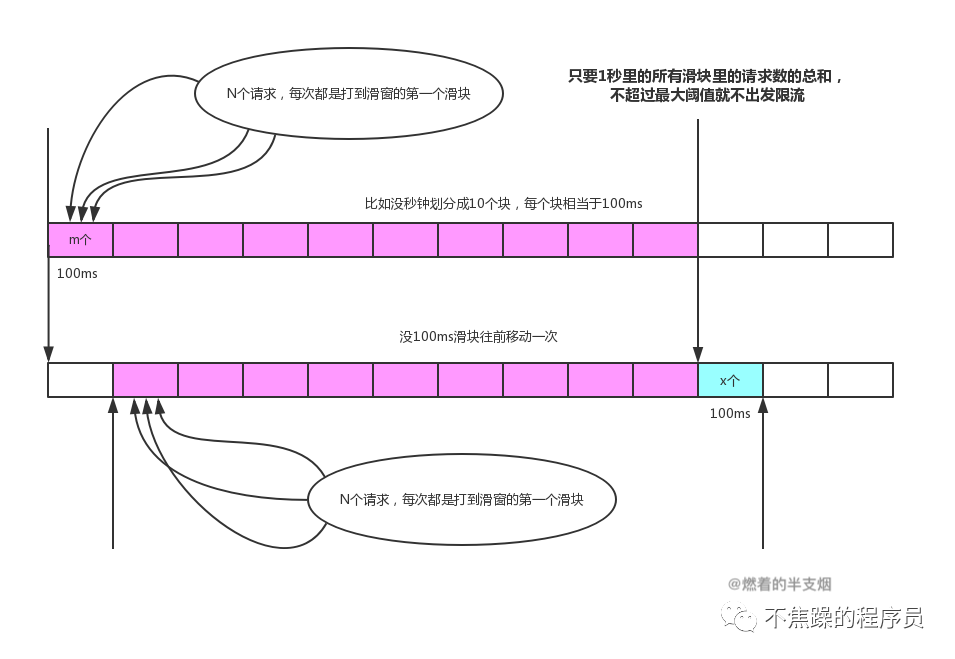Java實現系統限流
限流是保障系統高可用的方式之一,也是大廠高頻面試題,如果面試官問一句,“如何實現每秒鐘1000個請求的限流?”,你要是分分鐘給他寫上幾種限流方案,那豈不香哉,哈哈!話不多說,我來列幾種常用限流實現方式。

1、Guava RateLimiter
Guava是Java領域很優秀的開源項目,包含了日常開發常用的集合、String、緩存等, 其中RateLimiter是常用限流工具。
RateLimiter是基于令牌桶算法實現的,如果每秒10個令牌,內部實現,會每100ms生產1個令牌。
使用Guava RateLimiter,如下:
(1) 引入pom依賴:
<dependency>
<groupId>com.google.guava</groupId>
<artifactId>guava</artifactId>
<version>23.0</version>
</dependency>(2) 代碼:
public class GuavaRateLimiterTest {
//比如每秒生產10個令牌,相當于每100ms生產1個令牌
private RateLimiter rateLimiter = RateLimiter.create(10);
/**
* 模擬執行業務方法
*/
public void exeBiz() {
if (rateLimiter.tryAcquire(1)) {
try {
Thread.sleep(500);
} catch (InterruptedException e) {
e.printStackTrace();
}
System.out.println("線程" + Thread.currentThread().getName() + ":執行業務邏輯");
} else {
System.out.println("線程" + Thread.currentThread().getName() + ":被限流");
}
}
public static void main(String[] args) throws InterruptedException {
GuavaRateLimiterTest limiterTest = new GuavaRateLimiterTest();
Thread.sleep(500);//等待500ms,讓limiter生產一些令牌
//模擬瞬間生產100個線程請求
for (int i = 0; i < 100; i++) {
new Thread(limiterTest::exeBiz).start();
}
}
}2、滑窗計數
打個比方,某接口每秒允許100個請求,設置一個滑窗,窗口中有10個格子,每個格子占100ms,每100ms移動一次。滑動窗口的格子劃分的越多,滑動窗口的滾動就越平滑,限流的統計就會越精確。

代碼如下:
/**
* 滑窗計數器
*/
public class SliderWindowRateLimiter implements Runnable {
//每秒允許的最大訪問數
private final long maxVisitPerSecond;
//將每秒時間劃分N個塊
private final int block;
//每個塊存儲的數量
private final AtomicLong[] countPerBlock;
//滑動窗口劃到了哪個塊兒,可以理解為滑動窗口的起始下標位置
private volatile int index;
//目前總的數量
private AtomicLong allCount;
/**
* 構造函數
*
* @param block,每秒鐘劃分N個窗口
* @param maxVisitPerSecond 每秒最大訪問數量
*/
public SliderWindowRateLimiter(int block, long maxVisitPerSecond) {
this.block = block;
this.maxVisitPerSecond = maxVisitPerSecond;
countPerBlock = new AtomicLong[block];
for (int i = 0; i < block; i++) {
countPerBlock[i] = new AtomicLong();
}
allCount = new AtomicLong(0);
}
/**
* 判斷是否超過最大允許數量
*
* @return
*/
public boolean isOverLimit() {
return currentQPS() > maxVisitPerSecond;
}
/**
* 獲取目前總的訪問數
*
* @return
*/
public long currentQPS() {
return allCount.get();
}
/**
* 請求訪問進來,判斷是否可以執行業務邏輯
*/
public void visit() {
countPerBlock[index].incrementAndGet();
allCount.incrementAndGet();
if (isOverLimit()) {
System.out.println(Thread.currentThread().getName() + "被限流" + ",currentQPS:" + currentQPS() + ",index:" + index);
} else {
System.out.println(Thread.currentThread().getName() + "執行業務邏輯" + ",currentQPS:" + currentQPS() + ",index:" + index);
}
}
/**
* 定時執行器,
* 每N毫秒滑塊移動一次,然后再設置下新滑塊的初始化數字0,然后新的請求會落到新的滑塊上
* 同時總數減掉新滑塊上的數字,并且重置新的滑塊上的數量
*/
@Override
public void run() {
index = (index + 1) % block;
long val = countPerBlock[index].getAndSet(0);
allCount.addAndGet(-val);
}
public static void main(String[] args) {
SliderWindowRateLimiter sliderWindowRateLimiter = new SliderWindowRateLimiter(10, 100);
//固定的速率移動滑塊
ScheduledExecutorService scheduledExecutorService = Executors.newSingleThreadScheduledExecutor();
scheduledExecutorService.scheduleAtFixedRate(sliderWindowRateLimiter, 100, 100, TimeUnit.MILLISECONDS);
//模擬不同速度的請求
new Thread(() -> {
while (true) {
sliderWindowRateLimiter.visit();
try {
Thread.sleep(10);
} catch (InterruptedException e) {
e.printStackTrace();
}
}
}).start();
//模擬不同速度的請求
new Thread(() -> {
while (true) {
sliderWindowRateLimiter.visit();
try {
Thread.sleep(50);
} catch (InterruptedException e) {
e.printStackTrace();
}
}
}).start();
}
}3、信號量
利用Semaphore,每隔固定速率,釋放Semaphore的資源。線程獲取到資源,則執行業務代碼。
代碼如下:
public class SemaphoreOne {
private static Semaphore semaphore = new Semaphore(10);
public static void bizMethod() throws InterruptedException {
if (!semaphore.tryAcquire()) {
System.out.println(Thread.currentThread().getName() + "被拒絕");
return;
}
System.out.println(Thread.currentThread().getName() + "執行業務邏輯");
Thread.sleep(500);//模擬處理業務邏輯需要1秒
semaphore.release();
}
public static void main(String[] args) {
Timer timer = new Timer();
timer.scheduleAtFixedRate(new TimerTask() {
@Override
public void run() {
semaphore.release(10);
System.out.println("釋放所有鎖");
}
}, 1000, 1000);
for (int i = 0; i < 10000; i++) {
try {
Thread.sleep(10);//模擬每隔10ms就有1個請求進來
} catch (InterruptedException e) {
e.printStackTrace();
}
new Thread(() -> {
try {
SemaphoreOne.bizMethod();
} catch (InterruptedException e) {
e.printStackTrace();
}
}).start();
}
}
}4、令牌桶
令牌桶算法:一個存放固定容量令牌的桶,按照固定速率往桶里添加令牌,如有剩余容量則添加,沒有則放棄。如果有請求進來,則需要先從桶里獲取令牌,當桶里沒有令牌可取時,則拒絕任務。
令牌桶的優點是:可以改變添加令牌的速率,一旦提高速率,則可以處理突發流量。

代碼如下:
public class TokenBucket {
/**
* 定義的桶
*/
public class Bucket {
//容量
int capacity;
//速率,每秒放多少
int rateCount;
//目前token個數
AtomicInteger curCount = new AtomicInteger(0);
public Bucket(int capacity, int rateCount) {
this.capacity = capacity;
this.rateCount = rateCount;
}
public void put() {
if (curCount.get() < capacity) {
System.out.println("目前數量==" + curCount.get() + ", 我還可以繼續放");
curCount.addAndGet(rateCount);
}
}
public boolean get() {
if (curCount.get() >= 1) {
curCount.decrementAndGet();
return true;
}
return false;
}
}
@Test
public void testTokenBucket() throws InterruptedException {
Bucket bucket = new Bucket(5, 2);
//固定線程,固定的速率往桶里放數據,比如每秒N個
ScheduledThreadPoolExecutor scheduledCheck = new ScheduledThreadPoolExecutor(1);
scheduledCheck.scheduleAtFixedRate(() -> {
bucket.put();
}, 0, 1, TimeUnit.SECONDS);
//先等待一會兒,讓桶里放點token
Thread.sleep(6000);
//模擬瞬間10個線程進來拿token
for (int i = 0; i < 10; i++) {
new Thread(() -> {
if (bucket.get()) {
System.out.println(Thread.currentThread() + "獲取到了資源");
} else {
System.out.println(Thread.currentThread() + "被拒絕");
}
}).start();
}
//等待,往桶里放token
Thread.sleep(3000);
//繼續瞬間10個線程進來拿token
for (int i = 0; i < 10; i++) {
new Thread(() -> {
if (bucket.get()) {
System.out.println(Thread.currentThread() + "獲取到了資源");
} else {
System.out.println(Thread.currentThread() + "被拒絕");
}
}).start();
}
}
}5、總結
本文主要介紹了幾種限流方法:Guava RateLimiter、簡單計數、滑窗計數、信號量、令牌桶,當然,限流算法還有漏桶算法、nginx限流等等。我所寫的這些方法只是個人在實際項目總使用過的,或者是早年參加阿里筆試時寫過的方式。





































